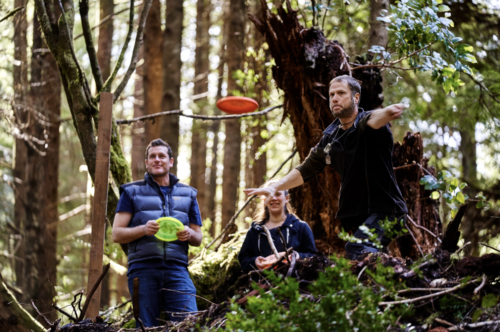
Every winter, about 20,000 gray whales (and the occasional blue, humpback and Orca) living in the north Pacific Ocean head south for the winter, much to the delight of visitors to the Oregon Coast.
Visitors can catch the fascinating spectacle anywhere along the Coast, but there’s just one spot that focuses all of its resources on educating the public about the unique behavior of whales.
The Depoe Bay Whale Watch Center employs 300 volunteers through its “Whale Watching Spoken Here” program, which marks its 40th year in 2018.
The volunteers are based at the Center in Depoe Bay but also stationed at the 23 other watch sites up and down the Coast. Volunteers are vacationing families, retirees and others who’ve taken a one-day training offered through Oregon State Parks.
So what does it mean to speak whale? We spoke with Luke Parsons, who oversees the volunteers as interpretive park ranger for the program.
Q: So you’ve been the “whale watch guy” at the Depoe Bay Whale Watch Center for almost a year now. What are the top three questions visitors ask you?
A: We have well over 100,000 people from all across the world come and visit us each year and we get many great questions, but the top three question would be: Are there actually any whales out there? (Yes.) What kinds of whales are we seeing? (Primarily grey.) What time do we feed them/ how do we get them to come so close? (Often, people think this is like Seaworld, and we feed them. I can assure you they are very much wild animals. They feed naturally. They’re feeding on plankton called mysid shrimp. That’s their only food source in the Depoe Bay area. They eat 2,000 pounds a day.)
Q: Where does your passion for whales come from?
A: Honestly, my passion is in education. I’ve been involved in environmental education for over a decade and I’ve lived all over the western U.S. I really enjoy connecting people of all ages and backgrounds with their parks, whether here at the Depoe Bay Whale Center or at any other great Oregon State Park. All of us live in a really amazing part of the world and I love to help people discover that.
Q: What’s the best reaction you’ve seen from a visitor upon spotting their first whale?
A: We see a range of emotions from people. Usually it’s just pure joy or astonishment. Often people will start to cry because they are just so happy. There was one day in July this year we had around 100 people in the building. A juvenile gray whale decided to breach, or jump, right in front of us less than 100 feet from our windows. It was like a New Year’s Eve party, people screaming, high-fiving and hugging each other — it was awesome!
Q: What do you tell visitors about the reason for the whales activities, as it relates to their own personal actions in the ecosystem?
A: We have people with varying levels of understanding about why these whales are here, and what makes the central Oregon Coast such a hot spot for whales. To get right down to it, it’s all about ocean health. Clean water is vital to whales and all other creatures that live in our oceans. We remind people to do their part in keeping Oregon’s waterways clean and free of chemicals or other contaminants. Ultimately, any pollution will end up in the Pacific Ocean can really harm everything that thrives there.
Q: What are some of the perks of being a Whale Watching Spoken Here volunteer? Your favorite part of the job?
A: First and foremost, you get to volunteer with a passionate group of people who care about the Oregon Coast and enjoy sharing it with others. Second, often you get to help people see their very first whale in the wild and share in their joy. Third, you get to camp at an Oregon State Park for free while you volunteer! As for my favorite part of the job, it’s getting to introduce people from all over the world to the beautiful Oregon coast and I know that every Oregon State Park Ranger knows we’re pretty lucky to have that honor.
Story by Jen Anderson
Photo by Morris Grover



